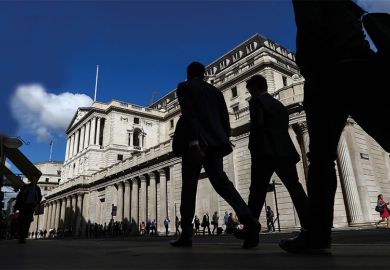The average Australian vice-chancellor’s pay packet reached seven figures last year, setting a high-water mark for remuneration of the sector’s leaders but raising questions about their strategic vision.
A Times Higher Education analysis found that the chiefs of the country’s 37 public universities pocketed an average of A$1,002,500 (£547,877) in 2019, almost A$20,000 more than the previous year. Vice-chancellors of the prestigious Group of Eight universities attracted an average of A$1,222,000, more than twice the typical remuneration of their counterparts in the UK’s Russell Group.
The gap would have been bigger but for the temperance of the Australian National University’s Brian Schmidt, whose earnings of A$649,396 made him Australia’s second lowest-paid vice-chancellor despite being the world’s only serving university president with a Nobel prize.
At the other end of the scale, the University of Sydney’s Michael Spence earned around A$1,627,500 – almost A$1 million more than he can expect when he takes the helm at UCL next year.
Higher education management expert Leo Goedegebuure said staff resentment over their bosses’ pay had probably contributed to academics’ reluctance to consider pay cuts or freezes during the Covid-induced financial crisis. Nevertheless, it was debatable whether A$1 million was enough.
“It’s a thankless job,” said Professor Goedegebuure, former director of the University of Melbourne’s LH Martin Institute. “It’s 24-7, living in a glass house. I wouldn’t want a job like that.”
It is now a less generously remunerated job, with most vice-chancellors accepting substantial pay cuts this year – typically 20 per cent – as Covid-related savings measures. Dr Spence and other Sydney executives followed suit in September after initially resisting.
Top-earning vice-chancellors, 2019
|
Vice-chancellor |
2019 |
2018 |
% change |
|
Michael Spence, University of Sydney |
A$1.63 million |
A$1.52 million |
6.9 |
|
Duncan Maskell, |
A$1.49 million
|
A$1.58 million*
|
−5.7
|
|
Greg Craven, |
A$1.36 million
|
A$1.33 million
|
2.3
|
|
Ian Jacobs, UNSW Sydney |
A$1.32 million |
A$1.29 million |
2.3 |
|
Margaret Gardner, Monash University |
A$1.29 million |
A$1.11 million |
16.3 |
Source: University annual reports. *Predecessor’s salary
But Professor Goedegebuure said that such gestures were inadequate. He said vice-chancellors’ earnings had been inflated by a corporate mindset that valued university leaders for their revenue-raising prowess – typically through international student recruitment – and now, with that approach torpedoed by the pandemic, it was time for fresh ideas and a different type of leadership.
Instead, universities were “firing people by the thousands. I would expect a much more measured response [recognising that] we’ve got a short-term issue and a long-term issue. Let’s deal with the short-term issue in the context of long-term solutions – and that is not by firing young staff.
“What we’ve seen is purely an internal response saying we’ve lost money, we need to cut in order to survive. It’s not about how can we strategically invest ourselves out of this. If you pay people that much money for an executive role in a complex organisation, that is what I would expect.”
He acknowledged that replacing the “rivers of gold” from international students was no easy challenge. “I don’t know the answer, but I’m not being paid a million bucks a year.”
Remuneration committees showed restraint last year, increasing vice-chancellors’ average earnings by 2 per cent – marginally more than the 1.9 per cent rise enjoyed by the average staff member, but well below the 5.2 per cent increase university bosses enjoyed in 2018.
Eleven institutions paid their leaders less in 2019 than in 2018, although in some cases this was because they were new in the role and their predecessors’ income had been inflated by separation payments.
POSTSCRIPT:
Print headline: Australian v-c pay averages A$1 million
Register to continue
Why register?
- Registration is free and only takes a moment
- Once registered, you can read 3 articles a month
- Sign up for our newsletter
Subscribe
Or subscribe for unlimited access to:
- Unlimited access to news, views, insights & reviews
- Digital editions
- Digital access to THE’s university and college rankings analysis
Already registered or a current subscriber?








